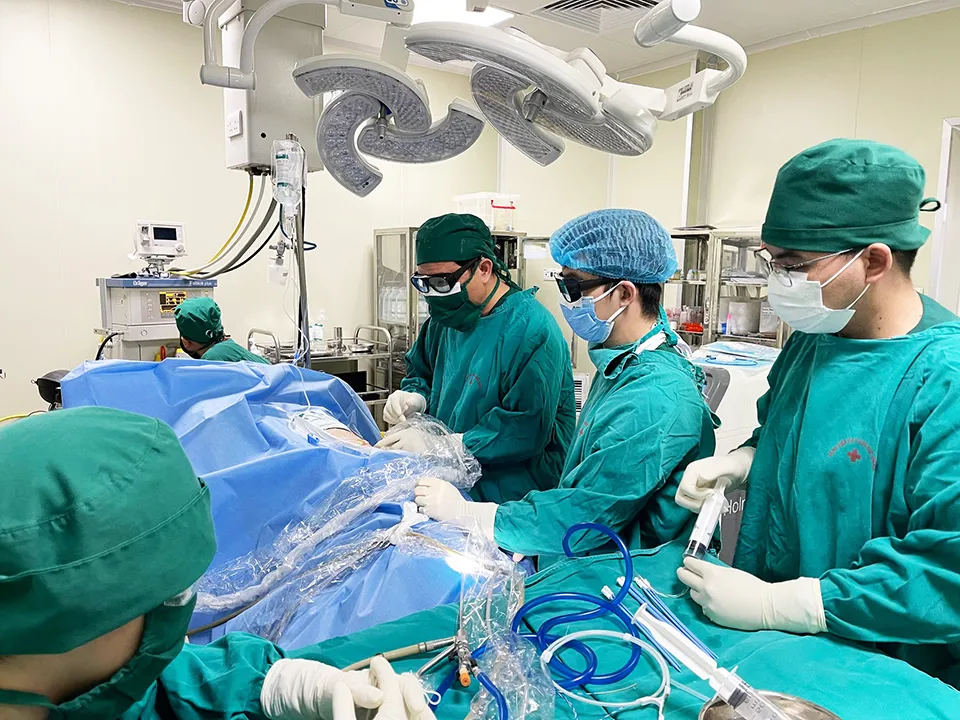Hanoi hospitals adjust service charges, remain confused about new pricing rule
The new circular on healthcare prices aims to ensure benefits for both patients and public healthcare institutions.
Since the Ministry of Health's Circular 13 on prices for medical services requested by patients and provided by public medical units took effect on August 15, Hanoi hospitals have made major changes to many of their technical medical services.
| An operation at Duc Giang General Hospital in Hanoi's Long Bien district. Photo: The Hanoi Times |
The circular, which came into effect on August 15, aims to regulate prices and fees for medical services at State-owned medical institutions, prevent abuse of health insurance by transferring patients to more expensive treatment areas, ensure the service capacity of public hospitals, and avoid harassment of patients.
In addition, the circular is expected to help hospitals improve their financial competency, which would lead to further professional improvement and increase the income of medical staff.
According to the circular, a hospital must reserve 20% of available beds for patient-requested medical examination and treatment services, and high-quality doctors can devote a maximum of 30% of their time to examining patients upon request.
In Vietnam's medical system, patients pay a fee for a requested service and to be seen by a doctor of their choice, otherwise they would be seen by any doctor assigned by the hospital. The more qualified the doctor, the higher the fee.
At the Vietnam-Germany Friendship Hospital, the fees for most of the nearly 1,500 requested medical services are now 10% to 30% lower than the ceiling set by the Ministry of Health in Circular 13.
For example, the fee for an on-demand medical examination was set at VND500,000 (US$20.8) per patient, regardless of the qualifications of the attending physician. Fees for bone fracture repair and neurosurgery have also been drastically reduced.
At the Hanoi Obstetrics and Gynecology Hospital, delivery fees have dropped from VND14-VND16 million (US$581-664) to VND4.3-VND6.7 million (US$178.5-278.1). However, the price of using the bed has risen to a maximum of VND3.8 million (US$157.7) per day.
According to Nguyen Duy Anh, director of the Hanoi Obstetrics and Gynecology Hospital, the hospital performs about 35,000 surgeries a year. The new price range would cut the hospital's income from technical operations in half.
Meanwhile, at Bach Mai General Hospital, the price for a medical examination by a doctor now ranges from VND300,000 to VND400,000 ($12.45 and $16.60), depending on the doctor's qualifications. The previous fee was VND70,000-150,000 (US$2.91-6.23).
According to Dao Xuan Co, director of Bach Mai General Hospital, the fees charged so far are much lower than those allowed by the new circular, especially for services covered by medical insurance. In addition, the prices of medical examinations are very low, which does not encourage health workers.
"To ensure the quality of medical services, fees should now be increased to cover other expenses during treatment," he said.
If properly enforced, the circular will help Vietnamese doctors maximize their capabilities and prevent Vietnamese patients from traveling abroad for medical treatment and spending money on foreign medical services," he said.
Problems arising
However, many hospital managers have said that they find it difficult to comply with the circular's provisions because many of them are impractical.
"It is difficult to price many of the services regulated by the circular because the prices of materials and equipment vary in the market," Director Anh of the Hanoi Obstetrics and Gynecology Hospital said at a recent meeting.
"There are thousands of items that need price changes, so it is difficult for public medical institutions to carry out price changes and professional operations at the same time in a short period of time."
Even the maximum charges for services cannot compensate for the initial investment the hospital has made in upgrading its facilities, he said.
Hospital managers do not know all the items and their prices in procurement, so what concerns them is how to buy the right items with good quality at reasonable prices without breaking the rules, Anh added.
"Prices and rates are suggested by the departments. If the purchased items are overpriced, the director should take responsibility."
Commenting on the new rules, Nguyen Van Thuong, director of Duc Giang General Hospital, said medical center managers now spend more time on procurement than on their professional activities.
Hospitals find it difficult to decide which items to buy because of differences in manufacturers, product categories, and operating standards, he explained.
"We also have accountability problems when it comes to explaining the selected items to the authorities."
To solve these problems, Director Anh suggested that the authorities set a price range for equipment and devices.
"Hospitals can update the price range every year based on the list already provided by the ministry. This way, we can buy the items that suit our financial conditions and professional needs," he said.
Tran Thi Nhi Ha, director of the Hanoi Department of Health, responded that medical facility managers need to update their skills to meet the new demands of today's world.
"The department is collecting feedback from local medical centers and hospitals, and then reports difficulties to the ministry to help them," she said. "We are working with the ministry to give the most specific instructions to local hospitals."











